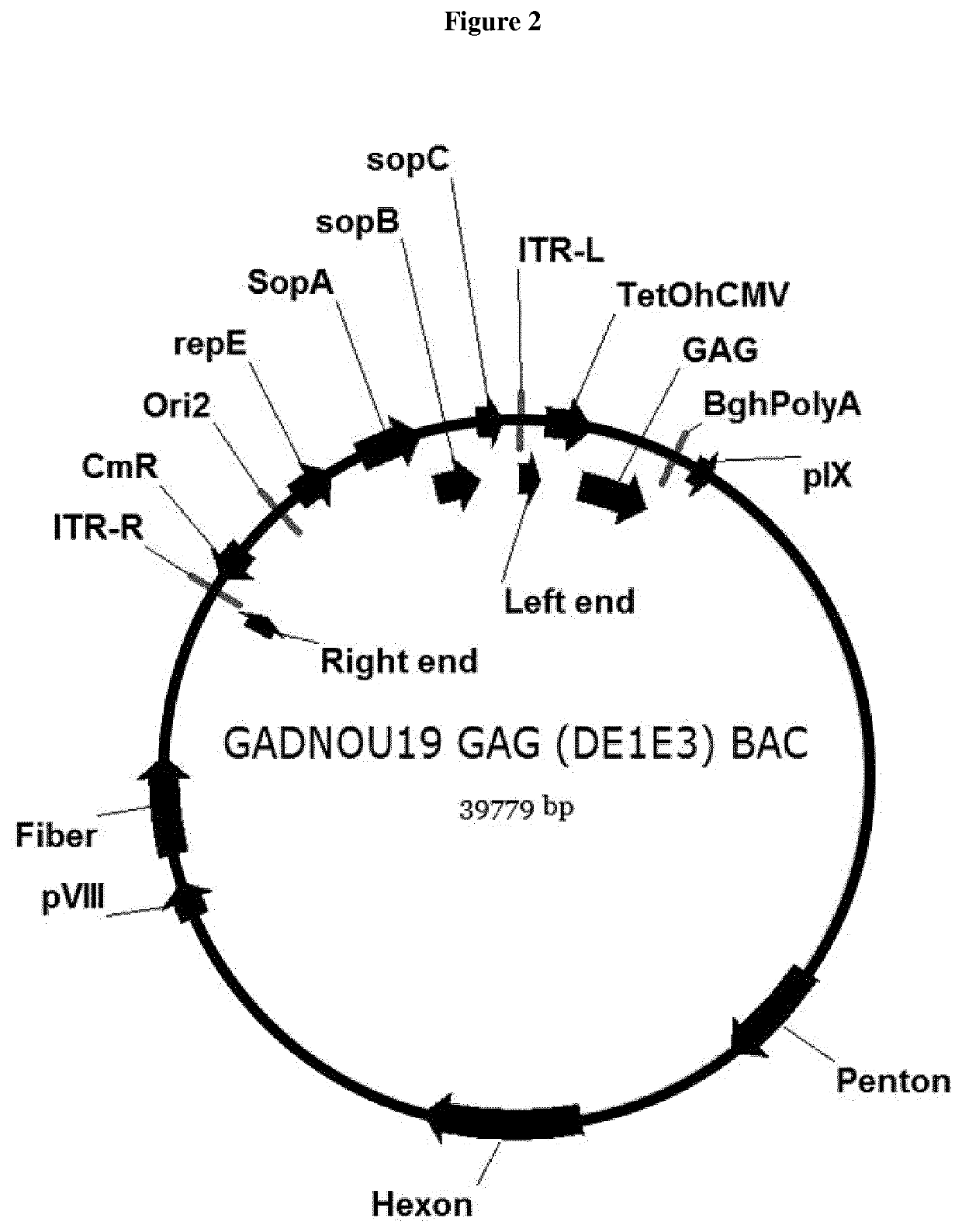Non human great apes adenovirus nucleic acid- and amino acid-sequences, vectors containing same, and uses thereof
a technology of adenovirus and amino acids, which is applied in the field of non human great apes adenovirus nucleic acid and amino acidsequences, vectors containing same, and can solve the problems of limiting the broad application of vectored vaccines and reducing the efficiency of gene transduction
- Summary
- Abstract
- Description
- Claims
- Application Information
AI Technical Summary
Benefits of technology
Problems solved by technology
Method used
Image
Examples
example 1
of New Adenoviral Vectors
[0209]The construction of pGADNOU19 and pGADNOU20 vectors proceeded through the steps provided below. The pGADNOU19 and pGADNOU20 vectors were derived from the wild type Adenovirus strains isolated from stool samples obtained from healthy non human great apes using standard procedures. The wild type viruses were isolated by inoculating monolayers of HEK 293 and A549 cell with stool extracts. Cell monolayers were observed daily for the appearance of a cytopathic effect. Samples scored positive by observation under the microscope were harvested and then the cells were lysed by freeze-thaw (−700° C. / 37° C.). The clarified cell lysate was then used for the virus propagation by infecting monolayers of fresh cells. After two passages of virus amplification, the adenovirus was purified by using standard procedures. The viral genome was extracted from purified viruses by SDS / proteinase K digestion followed by phenol-chloroform extraction. The purified adenovirus DNA...
example 2
n of GADNOU Shuttle Vectors
[0212]The purified DNA genomes of the GADNOU viruses were first sequenced and then the DNA sequence information used to construct a shuttle vector for cloning the entire genome of GAd by homologous recombination. The shuttle vector was designed to introduce the E1 region deletion (nucleotides coordinates: 461-3402). Briefly, the shuttle vector used to clone the GADNOU viruses (referred to herein as pGAd-GAG shuttle) was constructed as follows:
a, GAd-GAG left end was amplified by PCR with oligonucleotides FW 5′-GAACTCCgaattcgtttaaaccatcatcaataatataccttattttggattgaggccaatatgataatgaggtgggcggggcgaggc ggggcgggtgacgtagg-3′ (SEQ ID NO: 58) and RV 5′-cataatcGGCCGCAGCGGCCCGTCAG ATGACGGCGACAATAAA-3′ (SEQ ID NO: 59) digested with EcoRI and SfiI then ligated in pUC19 rc_MCS_Left end_PIX_Rightend_V1 digested with EcoRI and SfiI, thus generating pUC19 L-ITR GAd-GAG.
b. GAd right end was then amplified by PCR with oligonucleotides FW 5′-Cataatcgacccgagtcgcactctcacagcaccag...
example 3
ion of ΔE1 Vectors
[0214]GADNOU wt genomic DNA was isolated by Proteinase K digestion followed by phenol / chloroform extraction. pGADNOU19 and pGADNOU20 vectors were obtained by homologous recombination in E. coli strain BJ5183. Cloning of viral DNA was obtained by co-transforming E. coli strain BJ5183 cells with purified WT viral DNA and the BAC GAd-GAG A / L / S shuttle. Homologous recombination between pIX genes, right ITR DNA sequences present at the ends of shuttle BAC (digested with AscI) and viral genomic DNA allowed its insertion in the BAC vector, by deleting at the same time the E1 region that was substituted by the expression cassette, generating ΔE1 / GAG (BAC) vectors GADNOU19 GAG BAC and GADNOU20 GAG BAC. Screening was performed by restriction analysis and PCR sequencing on hexon region.
PUM
| Property | Measurement | Unit |
|---|---|---|
| Fraction | aaaaa | aaaaa |
| Acidity | aaaaa | aaaaa |
| Immunogenicity | aaaaa | aaaaa |
Abstract
Description
Claims
Application Information
 Login to View More
Login to View More - R&D
- Intellectual Property
- Life Sciences
- Materials
- Tech Scout
- Unparalleled Data Quality
- Higher Quality Content
- 60% Fewer Hallucinations
Browse by: Latest US Patents, China's latest patents, Technical Efficacy Thesaurus, Application Domain, Technology Topic, Popular Technical Reports.
© 2025 PatSnap. All rights reserved.Legal|Privacy policy|Modern Slavery Act Transparency Statement|Sitemap|About US| Contact US: help@patsnap.com



